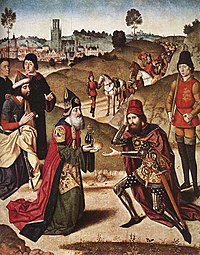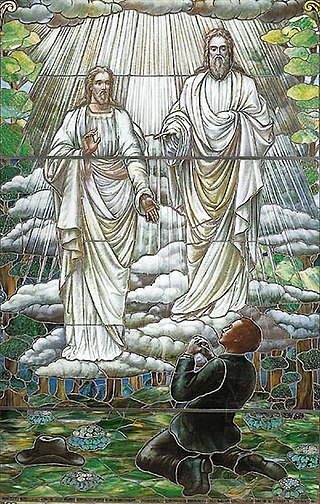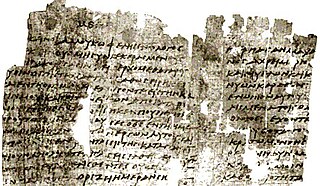
The priesthood of Melchizedek is a role in Abrahamic religions, modelled on Melchizedek, combining the dual position of king and priest. [1]

The priesthood of Melchizedek is a role in Abrahamic religions, modelled on Melchizedek, combining the dual position of king and priest. [1]
Melchizedek is a king and priest appearing in the Book of Genesis. The name means "King of Righteousness" – a name echoing kingly and priestly functions. [2] He is the first individual to be given the title Kohen (priest) in the Hebrew Bible.
In the King James Version the Book of Psalms 110:4 names Melchizedek as representative of the priestly line through which a future king of Israel's Davidic line was ordained. [3] Alternatively, it is suggested this term was here intended to be treated as an agglutinated improper noun, and thus translated as rightful king rather than left as a proper name Melchizedek; this interpretation is taken by some modern translations, such as the New JPS Tanakh.[ citation needed ]
The Law of Moses stipulates that only the male descendants of Aaron be commissioned to serve as Kohenim priests before Yahweh and the Jewish nation. This commission is believed in Judaism to be "a covenant of everlasting priesthood" and not eligible for replacement by other tribes of Israel.
Judaic midrash (exegesis) identifies Melchizedek with Shem the son of Noah. [4] Although the Book of Genesis affirms that Melchizedek was "priest of God Most High" (Genesis 14:18), the Midrash and Babylonian Talmud maintain that the priesthood held by Melchizedek, who pre-dated the patriarch Levi by five generations (Melchizedek pre-dates Aaron by six generations; Abraham, Isaac, Jacob, Levi, Kehoth, Amram, Aaron), was given in his stead to Abraham who, in turn, passed it on to his patrilineal descendants, Isaac and then to Jacob. Midrashic literature attributes this transition as a consequence due to Melchizedek preceding the name of Abraham to that of God, such as in the Midrash Rabbah to Genesis, [5] while some Jewish commentators, such as Chaim ibn Attar, write that Melchizedek gave the priesthood to Abraham willingly.
Maimonides, in his Mishneh Torah , explains that Jacob separated his son Levi from his other sons and appointed him to instruct and teach the ways of "service to God", specifically the servicial methods used by his forefather Abraham, to his brothers. He also instructed his sons to perpetuate this status of Levi ("Shevet Levi") for eternity (Maimonides, Avodah Zorah 1:15). For the prelude of this choice see Targum Jonathan to Genesis 32:25, and/or Pirkei de-Rabbi Eliezer ch. 37. In midrash, it is written that Amram the son of Kohath the son of Levi was the spiritual leader of the sons of Jacob ("Israel") during their Egyptian Bondage.[ citation needed ] Following his death, his post was assumed by his son Aaron.
At the time of the erection of the Tabernacle, the bible says that God commanded Moses to appoint Aaron and his sons to the Jewish priestly service as a precondition to God revealing his Shekhinah amongst the nation of Israel:
And Aaron and his sons I will sanctify to serve me and I will dwell amidst the sons of Israel and I will be to them a God, and they will know that I (am) God their Master that took them out from the land of Egypt (in order that) I (will) dwell in their midst
— Exodus 29:44-46
The majority of Chazalic literature attributes the primary character of psalm 110 as King David [6] who was a "righteous king" (מלכי צדק) of Salem (Jerusalem) and, like Melchizedek, had certain priest-like responsibilities, while the Babylonian Talmud understands the chapter as referring to Abram who was victorious in battling to save his nephew Lot and merited priesthood. [7] The Zohar defines the noted Melchizedek as referring to Ahron, High Priest of Israel. [8]
Christians believe that Jesus is the Messiah spoken of as "a priest forever in the order of Melchizedek" (Ps. 110:4), and so Jesus plays the role of the king-priest once and for all. According to the writer of Hebrews (7:13-17) Jesus is considered a priest in the order of Melchizedek because, like Melchizedek, Jesus was not a descendant of Aaron, and thus would not qualify for the Jewish priesthood under the Law of Moses.
Melchizedek is referred to again in Hebrews 5:6-10; Hebrews 6:20; Hebrews 7:1-21: "Thou art a priest forever after the order of Melchizedek"; and Hebrews 8:1.
And verily they that are of the sons of Levi, who receive the office of the priesthood, have a commandment to take tithes of the people according to the law, that is, of their brethren, though they come out of the loins of Abraham: But he whose descent is not counted from them received tithes of Abraham, and blessed him that had the promises" (Hebrews 7:5-6).
If therefore perfection were by the Levitical priesthood (for under it the people received the law), what further need was there that another priest should rise after the order of Melchizedek, and not be called after the order of Aaron? For the priesthood being changed, there is made of necessity a change also of the law" (Hebrews 7:11-12).
The author of the Epistle to the Hebrews in the New Testament discussed this subject considerably, listing the following reasons for why the priesthood of Melchizedek is superior to the Aaronic priesthood:
The epistle goes on to say that the covenant of Jesus is superior to the covenant the Levitical priesthood is under. Some Christians hold that Melchizedek was a type of Christ, and some other Christians hold that Melchizedek indeed was Christ. Reasons provided include that Melchizedek's name means "king of righteousness" according to the author of Hebrews, and that being king of Salem makes Melchizedek the "king of peace". Heb. 7:3 states, "Without father or mother, without genealogy, without beginning of days or end of life, like the Son of God he (Melchizedek) remains a priest forever." Melchizedek gave Abraham bread and wine, which Christians generally consider to pre-figure the Eucharist, being symbols or sacraments of the body and blood of Jesus Christ, and perhaps a sacrifice to confirm a covenant.[ citation needed ]
Catholics believe that Melchizedek was a prefiguration of the priesthood of Christ(CCC 1544). [9] In Genesis 14:18, Melchizedek offers a sacrifice of bread and wine. Catholics believe that Christ therefore fulfilled the prophecy of Ps 110:4, that he would be a priest "after the order of Melchizedek" at the Last Supper, when he initiated the sacrifice of the New Covenant with his disciples— his body and blood under the appearances of bread and wine. Melchizedek and his offering are explicitly referenced as a foreshadowing of the Sacrifice of the Mass in the liturgical prayers of the Roman Canon of the Catholic Mass. Catholic priests, in the doctrine of the Catholic Church, are priests inasmuch as they participate(CCC 1547) in the one priesthood of Christ according to the order of Melchizedek due to their ordination.
In the Latter Day Saint movement, the Melchizedek priesthood is viewed as the priesthood authority of the Twelve Apostles of Jesus, as well as Old Testament prophets, higher than that of the Aaronic authority of John the Baptist and of the Levites.
According to the Book of Mormon, the prophet Melchizedek preached repentance to the people of a wicked city, and established peace in the land. According to Alma13:18, Melchizedek's efforts earned him the title "the prince of peace". Of particular importance is the parallel Hebrew meaning of "prince of peace" and "king of Salem", another of Melchizedek's titles, and his association with (or typology of) Jesus Christ, who is also called the Prince of Peace (Isa. 9:2), as well as the Great High Priest (Heb. 4:14). Later, Melchizedek's people were, according to Joseph Smith, caught up, or "translated", to meet the city of Enoch (Joseph Smith Translation of Genesis 14:34). The priesthood is referred to by the name of Melchizedek because he was such a great high priest (Doctrine & Covenants Section 107:2). The Doctrine and Covenants states that before Melchizedek's day the Priesthood "was called the Holy Priesthood, after the Order of the Son of God. But out of respect or reverence to the name of the Supreme Being, to avoid the too-frequent repetition of his name, they, the church, in the ancient days, called that priesthood after Melchizedek, or the Melchizedek Priesthood" (Doctrine and Covenants Section 107:3-4). Initially, the only Melchizedek Priesthood office in the Latter Day Saint movement was Elder. Later revelations extended the office complement to Seventy, High Priest, Patriarch and Apostle.

According to Abrahamic religions, Aaron was a prophet, a high priest, and the elder brother of Moses. Information about Aaron comes exclusively from religious texts such as the Hebrew Bible, the New Testament, and the Quran.

Aaron's rod refers to any of the walking sticks carried by Moses' brother, Aaron, in the Torah. The Bible tells how, along with Moses' rod, Aaron's rod was endowed with miraculous power during the Plagues of Egypt that preceded the Exodus. Later, his rod miraculously sprouted blossoms and almonds to symbolize God's choice of Aaron and his tribe for holy service.
Kohen is the Hebrew word for "priest", used in reference to the Aaronic priesthood, also called Aaronites or Aaronides. They are traditionally believed and halakhically required to be of direct patrilineal descent from the biblical Aaron, brother of Moses, and thus belong to the Tribe of Levi.
In Mormonism, the Melchizedek priesthood, also referred to as the high priesthood of the holy order of God or the Holy Priesthood, after the Order of the Son of God, is the greater of the two orders of priesthood, the other being the Aaronic priesthood.
In the Latter Day Saint movement, priesthood is the power and authority of God given to man, including the authority to perform ordinances and to act as a leader in the church. A group of priesthood holders is referred to as a quorum.

The Aaronic priesthood is the lesser of the two orders of priesthood recognized in the Latter Day Saint movement. The others are the Melchizedek priesthood and the rarely recognized Patriarchal priesthood. Unlike the Melchizedek priesthood, which is modeled after the authority of Jesus and the Twelve Apostles, or the Patriarchal priesthood, which is modeled after the authority of Abraham, the Aaronic priesthood is modeled after the priesthood of Aaron the Levite, the first high priest of the Hebrews, and his descendants. The Aaronic priesthood is thought to be a lesser or preparatory priesthood and an "appendage" of the more powerful Melchizedek priesthood.
The Church of Jesus Christ of Latter-day Saints has several unique teachings about Judaism and the House of Israel. The largest denomination in the Latter Day Saint movement, the LDS Church teaches the belief that the Jewish people are God's chosen people and it also teaches the belief that its members share a common and literal Israelite ancestry with the Jewish people.
The patriarchal priesthood is associated with the patriarchal order found in Mormonism and is especially connected with celestial marriage.
The New Covenant is a biblical interpretation which was originally derived from a phrase which is contained in the Book of Jeremiah, in the Hebrew Bible.
In the Latter Day Saint movement, a bishop is the highest office of the Aaronic priesthood. It is almost always held by one who holds the office of high priest in the Melchizedek priesthood. The Latter Day Saint concept of the office differs significantly from the role of bishops in other Christian denominations, being in some respects more analogous to a pastor or parish priest. Each bishop serves with two counselors, who together form a bishopric.
The Hebrew Bible makes reference to a number of covenants with God (YHWH). These include the Noahic Covenant set out in Genesis 9, which is decreed between God and all living creatures, as well as a number of more specific covenants with Abraham, the whole Israelite people, the Israelite priesthood, and the Davidic lineage of kings. In form and terminology, these covenants echo the kinds of treaty agreements existing in the surrounding ancient world.
Zadok or Zadok HaKohen, also spelled Ṣadok, Ṣadoc, Zadoq, Tzadok or Tsadoq, was a Kohen (priest), biblically recorded to be a descendant from Eleazar the son of Aaron. He was the High Priest of Israel during the reigns of David and Solomon. He aided King David during the revolt of his son Absalom, was subsequently instrumental in bringing Solomon to the throne and officiated at Solomon's coronation. After Solomon's building of the First Temple in Jerusalem, Zadok was the first High Priest to serve there.

Lech-Lecha, Lekh-Lekha, or Lech-L'cha is the third weekly Torah portion in the annual Jewish cycle of Torah reading. It constitutes Genesis 12:1–17:27. The parashah tells the stories of God's calling of Abram, Abram's passing off his wife Sarai as his sister, Abram's dividing the land with his nephew Lot, the war between the four kings and the five, the covenant between the pieces, Sarai's tensions with her maid Hagar and Hagar's son Ishmael, and the covenant of circumcision.

In the Bible, Melchizedek, also transliterated Melchisedech or Malki Tzedek, was the king of Salem and priest of El Elyon. He is first mentioned in Genesis 14:18–20, where he brings out bread and wine and then blesses Abram and El Elyon.
In the Church of Jesus Christ of Latter-day Saints, the priesthood is the power and authority to act in the name of God for the salvation of humankind. Male members of the church who meet standards of worthy behavior and church participation are generally ordained to specific offices within the priesthood.

The Church of Jesus Christ of Latter-day Saints focuses its doctrine and teaching on Jesus Christ; that he was the Son of God, born of Mary, lived a perfect life, performed miracles, bled from every pore in the Garden of Gethsemane, died on the cross, rose on the third day, appeared again to his disciples, and now resides, authoritatively, on the right hand side of God. In brief, some beliefs are in common with Catholics, Orthodox and Protestant traditions. However, teachings of the LDS Church differ significantly in other ways and encompass a broad set of doctrines, so that the above-mentioned denominations usually place the LDS Church outside the bounds of orthodox Christian teaching as summarized in the Nicene Creed.
According to Judaism, the priestly covenant is the biblical covenant that God gave to Aaron and his descendants, the kohanim. This covenant consisted of their exclusive right to serve in the Temple, and to consume sacrificial offerings and receive other priestly gifts.
In rabbinic Jewish eschatology, the Righteous Priest or Priest of Righteousness is a figure identified with one of the Four Craftsmen in a vision mentioned in the Book of Zechariah. He is found in the Talmud and Midrash.

Hebrews 5 is the fifth chapter of the Epistle to the Hebrews in the New Testament of the Christian Bible. The author is anonymous, although the internal reference to "our brother Timothy" causes a traditional attribution to Paul, but this attribution has been disputed since the second century and there is no decisive evidence for the authorship. This chapter contains the exposition about the merciful Christ and the High Priests, followed by an exhortation to challenge the readers beyond the elementary catechism.

Hebrews 7 is the seventh chapter of the Epistle to the Hebrews in the New Testament of the Christian Bible. The author is anonymous, although the internal reference to "our brother Timothy" causes a traditional attribution to Paul, but this attribution has been disputed since the second century and there is no decisive evidence for the authorship. This chapter contains the exposition about the superiority of Christ's Priesthood through Melchizedek to the Levitical Priesthood.